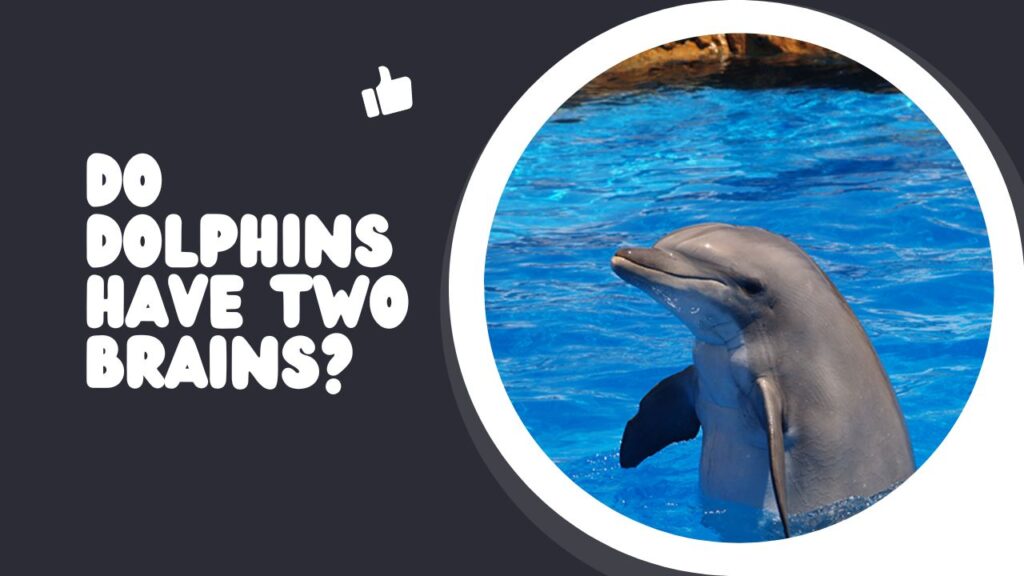
Do Dolphins Have Two Brains? Dolphins do not have two brains. They have a complex, highly developed single brain like other mammals.
Hey there! So, here’s the scoop: despite what some folks might think, dolphins actually have pretty impressive brains! Their noggin is big and super organized, perfect for their life underwater.
Their brain’s divided into parts, which helps them do all sorts of things at once, like chatting with their pals while swimming and grabbing a breath of air.
This setup gives dolphins some serious smarts, from solving problems to hanging out with their pod buddies.
Knowing how awesome dolphin brains are helps us understand and protect these clever sea creatures even more. Let’s give a round of applause for those amazing dolphin brains! [Do Dolphins Have Two Brains?]
Table of Contents
- 1 The Myth Of Dolphins Having Two Brains
- 2 The Reality: Dolphin Brain Structure And Function
- 3 Dolphin Intelligence: What Sets Them Apart?
- 4 Communicating With Clicks And Whistles: Dolphin Language
- 5 The Unforgettable Dolphin Memory
- 6 Unlocking The Mysteries: Ongoing Studies And Future Research
- 7 Frequently Asked Questions For Do Dolphins Have Two Brains?
- 8 Conclusion
The Myth Of Dolphins Having Two Brains
The long-standing notion that dolphins possess two brains stems from the anatomical structure of their dual hemispheres. However, this belief is a misconception.
Dolphins do not have two distinct brains, contrary to popular belief. Rather, their brain structure is intricate, facilitating a wide array of cognitive functions. This misconception may have originated from a misunderstanding of dolphin brain anatomy.
While dolphins are undeniably intelligent, attributing their abilities to a false anatomical feature is inaccurate. Their brain structure allows for exceptional skills in communication and problem-solving.
It’s crucial to correct this misconception and appreciate the true capabilities of dolphins, rooted in their sophisticated brain structure.
Understanding the complexities of dolphin brain anatomy sheds light on their cognitive abilities and dispels misconceptions surrounding their intelligence.

The Reality: Dolphin Brain Structure And Function
Do Dolphins Have Two Brains? It’s amazing to learn about the structure and functionality of dolphin brains. A few important characteristics of the human and dolphin brains are comparable.
The dolphin brain has sophisticated mechanisms that allow it to process emotions, communicate, and solve problems, while not being divided into two different hemispheres.
In addition, their highly developed neocortex exhibits sophisticated cognitive functions, which adds to their extraordinary intelligence. [Do Dolphins Have Two Brains?]
Scientists and amateurs alike are enthralled with the peculiar feature of the dolphin brain, which illuminates the complexities of marine life.
Dolphin Intelligence: What Sets Them Apart?
Researchers and amateurs alike are captivated by the amazing intellect of dolphins. They are genuinely exceptional because they have sophisticated behaviors and a high degree of social engagement.
Unlike humans, who primarily use one hemisphere at a time, dolphins have two distinct brain hemispheres that allow them to process information concurrently.
Their brains contain dedicated areas for a variety of tasks, like as navigation, problem-solving, and communication. [Do Dolphins Have Two Brains?]

Dolphin intelligence is characterized in part by its capacity for efficient interpersonal communication. They have a sophisticated communication system that combines body language, clicks, and whistles.
They are able to communicate, plan activities for the group, and even demonstrate mutual understanding because of this.
Dolphins also display problem-solving skills, such as using objects as tools to accomplish tasks and working collaboratively as a team.
| Complex Behaviors | Social Interactions |
| Dolphins exhibit a range of complex behaviors like tool usage, self-recognition, and mirror self-recognition. | They live in intricate social groups called pods, where cooperation and coordination are vital. |
| Dolphins demonstrate a capacity for creativity in their play and ability to interact with their environment. | They engage in vocal exchanges, mating rituals, and nurturing relationships within their pods. |
| Dolphins possess a remarkable instinct for survival and adaptability to changing environments. | They display altruistic behaviors, such as helping injured or distressed individuals in their pod. |
In summary, dolphins have remarkable intellect as seen by their intricate activities and social relationships.
Their exceptional cognitive ability can be attributed to their complex communication systems and dual-brain anatomy.
We can learn more about the wide spectrum of abilities present in the animal kingdom by studying dolphins. [Do Dolphins Have Two Brains?]
See Also: Do Dolphins Have Ultrasound? Unveiling the Hidden Wonders
Communicating With Clicks And Whistles: Dolphin Language
Dolphins are renowned for using a variety of vocalizations in their unusual means of communication. These vocalizations, which include whistles and clicks, are important components of dolphin communication.
Dolphins emit brief, high-frequency sound pulses called clicks through their blowholes. [Do Dolphins Have Two Brains?]
They can travel and find items in their environment by using a mechanism called echolocation, which they accomplish by clicking.
Dolphins can identify an object’s position, size, and shape by clicking and listening for the echoes that return.
Dolphins utilize whistles in addition to clicks to communicate. Dolphins use their blowholes to make whistles, which are longer, more melodic noises.
Every dolphin in a social group may be recognized by the distinctive whistle they generate, which serves as a sort of moniker.
These unusual means of communication reveal the social dynamics and intelligence of dolphins, showing that they have evolved sophisticated ways of engaging with their surroundings and with each other.
See Also: Do Dolphins Have Dicks? The Unrevealed Secret
The Unforgettable Dolphin Memory
Dolphins are renowned for having extraordinary memories and outstanding intelligence. [Do Dolphins Have Two Brains?]
According to studies, dolphins have an amazing long-term memory that enables them to retain the identities of certain people and events for a very long time.
This amazing talent has important ramifications for dolphin conservation initiatives and scientific studies.
For dolphins to survive in the wild, their long-term memory is essential. Dolphins are able to create intricate social interactions and alliances because they can remember earlier experiences and recognize other dolphins.
Comprehending this facet of dolphin behavior can aid conservationists in formulating conservation tactics to safeguard these remarkable aquatic organisms.
The evidence of long-term memory in dolphins presents interesting potential for scientific inquiry. By examining dolphins’ cognitive capacities, researchers can learn more about the peculiarities of their cerebral structures.
Advances in fields like artificial intelligence, neuroscience, and animal communication may result from this understanding.
See Also: Do Dolphins Have Nostrils? Discover the Fascinating Truth!
Unlocking The Mysteries: Ongoing Studies And Future Research
Dolphins, the brainiacs of the sea, have captivated experts worldwide, sparking ongoing research into their remarkable cognitive abilities. Recent studies reveal that dolphins are not only self-aware but also boast sophisticated problem-solving skills within their intricate social structures.
Communication is a key focus, with researchers decoding the clicks, whistles, and sounds that shape dolphin conversations. Unique whistles are identified as markers of individual identity, showcasing advanced social cognition.
Dispelling a common misconception, dolphins don’t have two brains, but their complex cerebral hemispheres enable multitasking, from breathing regulation to navigation.
Future research avenues aim to unravel the intricacies of dolphin cognition, potentially impacting artificial intelligence and linguistics. Understanding their social dynamics might illuminate human collaboration while delving into their brains contributes to our grasp of intelligence evolution.
Beyond intellectual pursuits, studying dolphin cognition holds promise for conservation and welfare, aiding in the development of effective strategies for their protection.
| Research Focus | Recent Findings | Future Directions |
|---|---|---|
| Cognitive Abilities | Self-awareness, problem-solving, social structures | Impact on artificial intelligence and linguistics |
| Communication Systems | Clicks, whistles, unique sounds | Insight into human societies and collaboration |
| Brain Structure | Complex cerebral hemispheres | Understanding the evolution of intelligence |
| Conservation & Welfare | Strategies for protection | Enhancing conservation efforts, ensuring the welfare of these creatures |
See Also: Do Dolphins Have Knees? Decoding the Aquatic Mystery
Frequently Asked Questions For Do Dolphins Have Two Brains?
Do Dolphins Have Two Brains?
No, dolphins do not have two brains. They have a highly developed brain that allows them to perform complex cognitive tasks and communicate with each other.
Can Dolphins Think Like Humans?
While dolphins have a high level of intelligence, they do not think like humans. They have their own unique way of processing information and solving problems. [Do Dolphins Have Two Brains?]
How Smart Are Dolphins Compared To Humans?
Dolphins are highly intelligent creatures, but their intelligence cannot be directly compared to humans. They excel in certain areas such as social cognition and problem-solving, but humans have a different set of cognitive abilities.
Do Dolphins Have A Language?
Dolphins communicate using a complex system of clicks, whistles, and body gestures. While their communication is highly sophisticated, it is not considered a language in the same way humans have language.
Conclusion
In conclusion, the notion that dolphins possess two brains is an intriguing one that has piqued people’s interest. Dolphins do not have two distinct brains, despite the fact that they do have sophisticated brain architecture and impressive cognitive ability.
Instead, their fully developed cerebral hemispheres provide remarkable social interaction, communication, and problem-solving abilities.
The notion might arise from the way dolphins use their brains differently, but don’t worry—dolphins are extremely clever animals that have a strong connection to the water.

Mr. Das, a certified pharmaceutical scientist, holds a Bachelor of Science in Pharmaceutical Sciences and passionately contributes to dolphin conservation as a member of the committee in Bangladesh.


